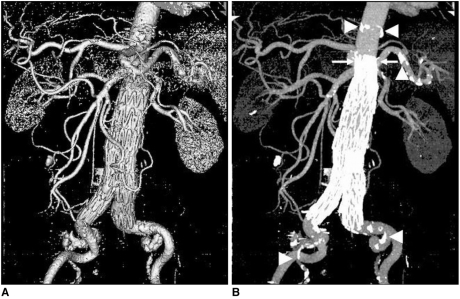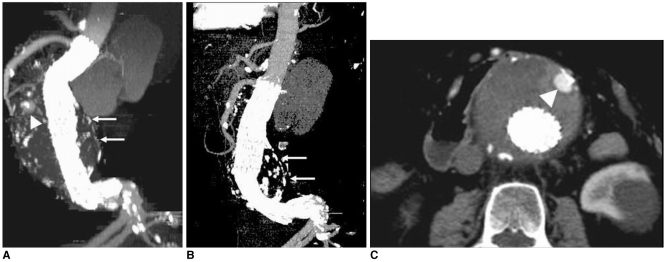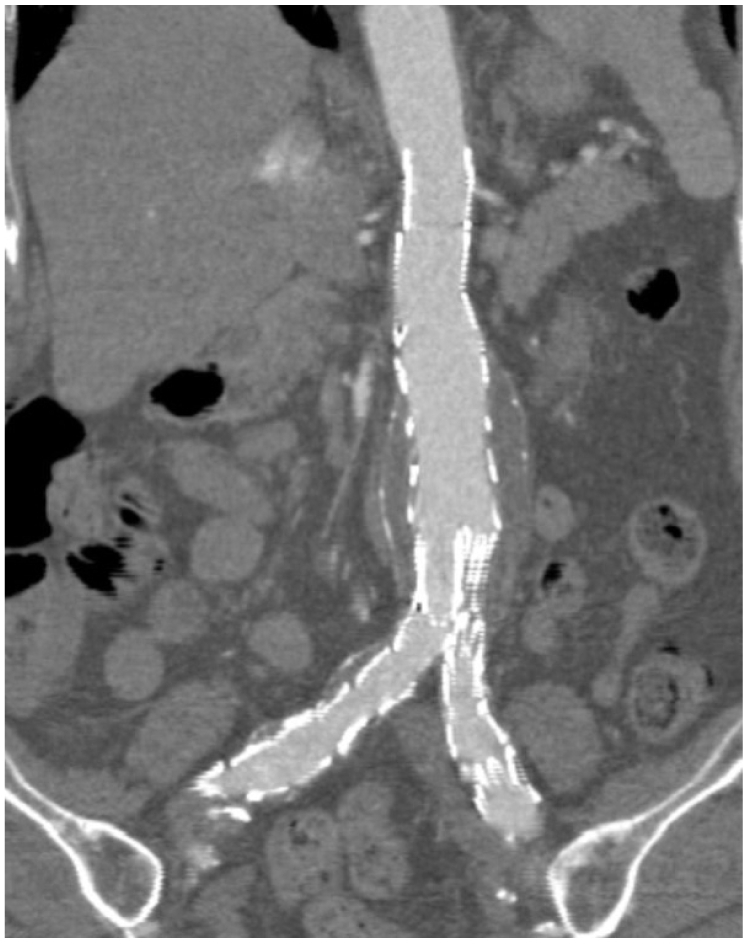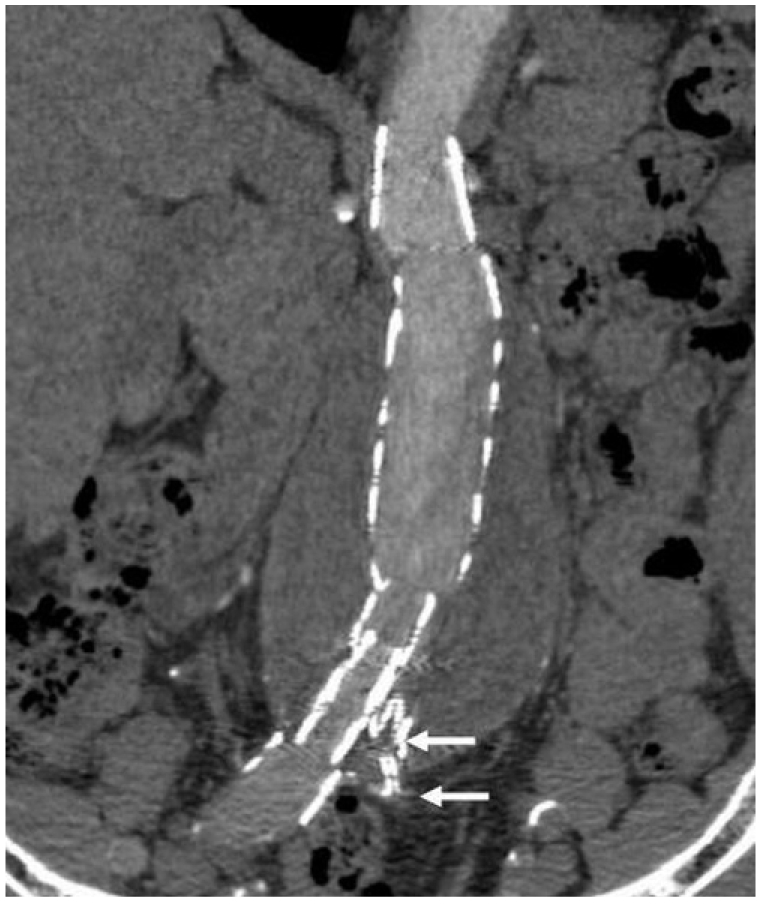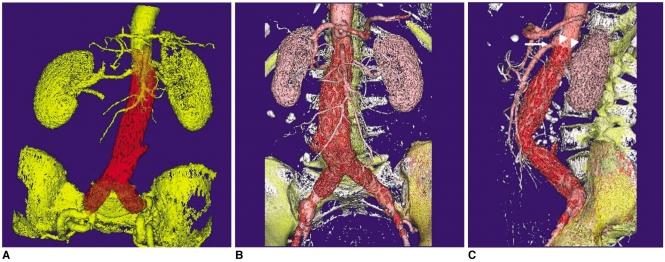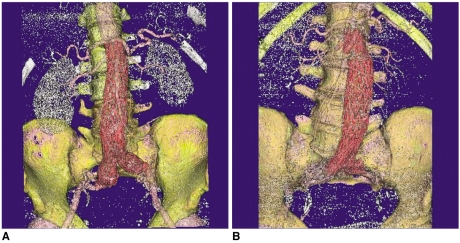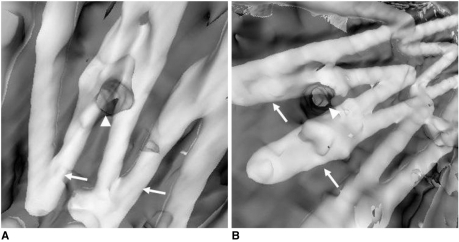Korean J Radiol.
2006 Sep;7(3):205-211. 10.3348/kjr.2006.7.3.205.
3D Multislice CT Angiography in Post-Aortic Stent Grafting: A Pictorial Essay
- Affiliations
-
- 1Discipline of Medical Imaging, Department of Imaging and Applied Physics, Curtin University of Technology, Perth, Western Australia. z.sun@curtin.edu.au
- KMID: 1114354
- DOI: http://doi.org/10.3348/kjr.2006.7.3.205
Abstract
- Helical CT angiography has been widely used in both pre- and post-aortic stent grafting and it has been confirmed to be the preferred modality when compared to conventional angiography. The recent development of multislice CT (MSCT) has further enhanced the applications of CT angiography for aortic stent grafting. One of the advantages of MSCT angiography over conventional angiography is that the 3D reconstructions, based on the volumetric CT data, provide additional information during follow-up of aortic stent grafting. While endovascular repair has been increasingly used in clinical practice, the use of 3D MSCT imaging in endovascular repair continues to play an important role. In this pictorial essay, we aimed to discuss the diagnostic performance of 3D MSCT angiography in post aortic stent grafting, including the most commonly used surface shaded display, curvilinear reformation, the maximum intensity projection, volume rendering and virtual endoscopy. The advantages and disadvantages of each 3D reconstruction are also explored.
MeSH Terms
Figure
Cited by 1 articles
-
Value of 3-Dimensional CT Virtual Anatomy Imaging in Complex Foreign Body Retrieval from Soft Tissues
Xiu-Jun Yang, Guang-Fu Xing, Chang-Wen Shi, Wei Li
Korean J Radiol. 2013;14(2):269-277. doi: 10.3348/kjr.2013.14.2.269.
Reference
-
1. Buth J, van Marrewijk CJ, Harris PL, Hop WC, Riambau V, Laheij RJF, et al. Outcome of endovascular abdominal aortic aneurysm repair in patients with conditions considered unfit for an open procedure: a report on the EUROSTAR experience. J Vasc Surg. 2002; 35:211–221. PMID: 11854717.
Article2. Cao P, Verzini F, Parlani G, Romano L, De Rango P, Pagliuca V, et al. Clinical effect of abdominal aortic aneurysm endografting: 7-year concurrent comparison with open repair. J Vasc Surg. 2004; 40:841–848. PMID: 15557895.
Article3. Prinssen M, Verhoeven EL, Buth J, Cuypers PW, van Sambeek MR, Balm R, et al. A randomized trial comparing conventional and endovascular repair of abdominal aortic aneurysms. N Engl J Med. 2004; 351:1607–1618. PMID: 15483279.
Article4. Broeders IA, Blankensteijn JD, Olree M, Mali W, Eikelboom BC. Preoperative sizing of grafts for transfemoral endovascular aneurysm management: a prospective comparative study of spiral CT angiography, arteriography and conventional CT imaging. J Endovasc Surg. 1997; 4:252–261. PMID: 9291050.
Article5. Armerding MD, Rubin GD, Beaulieu CF, Slonim SM, Olcott EW, Samuels SL, et al. Aortic aneurysmal disease: assessment of stent-graft treatment-CT versus conventional angiography. Radiology. 2000; 215:138–146. PMID: 10751479.
Article6. Hu H, He HD, Foley WD, Fox SH. Four multidetector-row helical CT: image quality and volume coverage speed. Radiology. 2000; 215:55–62. PMID: 10751468.
Article7. Rubin GD, Shiau MC, Leung AN, Kee ST, Logan LJ, Sofilos MC. Aorta and iliac arteries: single versus multiple detector-row helical CT angiography. Radiology. 2000; 215:670–676. PMID: 10831682.
Article8. Sun Z, Winder RJ, Kelly BE, Ellis PK, Kennedy PT, Hirst DG. Diagnostic value of CT virtual intravascular endoscopy in aortic stent grafting. J Endovasc Ther. 2004; 11:13–25. PMID: 14748633.9. Sun Z, Winder RJ, Kelly BE, Ellis PK, Hirst DG. CT virtual intravascular endoscopy of abdominal aortic aneurysms treated with suprarenal endovascular stent grafting. Abdom Imaging. 2003; 28:580–587. PMID: 14580104.
Article10. Davis CP, Ladd ME, Romanowski BJ, Wildermuth S, Knoplioch JF, Debatin JF. Human aorta: preliminary results with virtual endoscopy based on three-dimensional MR imaging data sets. Radiology. 1996; 199:37–40. PMID: 8633169.
Article11. Neri E, Bonanomi C, Vignali R, Cioni R, Ferrari M, Petruzzi P, et al. Spiral CT virtual endoscopy of abdominal arteries: clinical applications. Abdom Imaging. 2000; 25:59–61. PMID: 10652924.
Article12. Luccichenti G, Cademartiri F, Pezzella FR, Runza G, Belgrano M, Midiri M, et al. 3D reconstruction techniques made easy: know-how and pictures. Eur Radiol. 2005; 15:2146–2156. PMID: 15809826.
Article13. Sun Z. Three-dimensional visualization of suprarenal aortic stent-grafts: evaluation of migration in midterm follow-up. J Endovasc Ther. 2006; 13:85–93. PMID: 16445328.14. Sun Z, Zheng H. Helical CT angiography of aortic stent grafting: Comparison of three-dimensional rendering techniques. Lecture Notes in Computer Sciences. 2004; 3314:544–549.
Article15. Sun Z, Zheng H. Cross-sectional area reduction of the aortic ostium by suprarenal stent wires: in vitro phantom study by CT virtual angioscopy. Comput Med Imaging Graph. 2004; 28:345–351. PMID: 15294312.
Article16. Willmann JK, Baumert B, Schertler T, Wildermuth S, Pfammatter T, Verdun FR, et al. Aortoiliac and lower extremity arteries assessed with 16-detector row CT angiography: prospective comparison with digital subtraction angiography. Radiology. 2005; 236:1083–1093. PMID: 16055691.
Article17. Schertler T, Wildermuth A, Alkadhi H, Kruppa M, Marincek B, Boehm T. Sixteen-detector row CT angiography for lower-leg arterial occlusive disease: analysis of section width. Radiology. 2005; 237:649–656. PMID: 16244274.
Article18. Raff GL, Gallagher MJ, O'Neill WW, Goldstein JA. Diagnostic accuracy of noninvasive coronary angiography using 64-slice spiral computed tomography. J Am Coll Cardiol. 2005; 46:552–557. PMID: 16053973.
Article19. Flohr T, Stierstorfer K, Raupach R, Ulzheimer S, Bruder H. Performance evaluation of a 64-slice CT system with z-flying focal spot. Rofo. 2004; 176:1803–1810. PMID: 15573292.
Article20. Rydberg J, Kopecky KK, Lalka SG, Johnson MS, Dalsing MC, Persohn SA. Stent grafting of abdominal aortic aneurysms: pre- and postoperative evaluation with multislice helical CT. J Comput Assist Tomogr. 2001; 25:580–586. PMID: 11473190.
- Full Text Links
- Actions
-
Cited
- CITED
-
- Close
- Share
- Similar articles
-
- Multislice CT Angiography of Fenestrated Endovascular Stent Grafting for Treating Abdominal Aortic Aneurysms: a Pictorial Review of the 2D/3D Visualizations
- Multislice CT Virtual Intravascular Endoscopy for Assessing Pulmonary Embolisms: a Pictorial Review
- The Utility of 64 Channel Multidetector CT Angiography for Evaluating the Renal Vascular Anatomy and Possible Variations: a Pictorial Essay
- Angiographic Insights and Endovascular Intervention in Pulmonary Artery Pseudoaneurysms: A Comprehensive Clinical and Pictorial Essay
- CT Findings of Central Airway Lesions Causing Airway Stenosis-Visualization and Quantification: A Pictorial Essay

